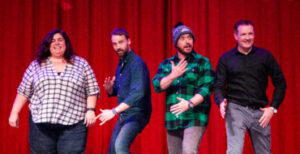 Birth
Birth hits the stage with rollicking passion and storytelling flair – probably everything that was missing from grade nine sex ed. The first play by non-profit theatre society 75 Cent Productions traces the history of birth, and attitudes towards it, from the 1600s to today. While its characters occasionally find themselves teetering with one foot over the soapbox, the play’s unique style and fast-paced blend of humour and pathos are organized into a highly engaging and consistently funny night of theatre.
Birth opens with the juxtaposition of two women’s experiences of birth, one living in 1753, one in modern day. This sequence establishes the play’s central question: how did birth come to this, and what comes next? The subsequent historical trek examines the themes of sexism, oppression, and scientific fallibility with a combination of comedy and drama.
The first act, which spans from 1601 to the mid-1900s, highlights historical flaws and misunderstandings surrounding the process of birth. It’s to the credit of playwright and director Rebecca Ryan that the material rarely bogs us down; though the content can be unpleasant, its treatment is even, and the play never wallows. This evenness comes from thematic commitment. Each character’s story, though high in personal drama, maintains our connection to the larger story of birth itself.
As much pathos as there is in the play’s oppressed, under-valued, or mistreated characters, we retain the sense that the forces at work are those of the evolution of society and its perception. Even the arrogant doctors and gentleman surgeons, powerful within their own scenes, become subject to the tides of history as the play moves inexorably on. The first act’s final scene is one of its best and its funniest (with actor Adam Boys displaying with aplomb the third of his four accents in the play). It effectively consolidates the manifold medical outlooks of the time into the contrasting characters of Joseph B. Delee and Fernand Lamaze, two men who exemplify the contradictory stances on how birth should be conducted.
The cleverly staged second act brings the play into the high-paced environment of a modern hospital, where nervous teenage fathers-to-be share the halls with midwife-touting pregnant women and even a Russian pimp (actor Amy Harkness, a particular comedic delight). It’s here, probably, that we as the audience fully hit our stride with the play. When we see the modern-day birth process as a continuation of historical methods and attitudes, we can’t help but wonder how much more sense there is in the way that we perceive and approach birth today. Of course, no-one’s bleeding pregnant women or pulling babies out with forceps anymore, and that’s pretty darn sensible in itself.
The second act is more comfortable, and though the themes of sexism and oppression do remain, there’s an undeniable joy to be found in the freedom which many of the act’s female characters enthusiastically exercise. It’s especially gratifying to see Shayna Jones, who powerfully portrays the much-abused slave girl Anarcha in the first act, allowed to gleefully inhabit the casual, clueless cool of mother-to-be Mary-Anne. Mary-Anne is most concerned that her makeup artist and birth photographer provide her with a birth picture that’s “frame-able,” and the contrast to the problems faced by women in the first act is sharply funny.
The play’s unique format allows many of the actors a chance at multiple roles. It’s a pleasure to see actors perform a memorable part, and then quickly flout audience expectations with a completely different second character. Our quick acceptance of the actors in each new role is evidence of the uniform talent on display.
The well-balanced, ensemble nature of such a quick-paced play allows for an ebb and flow of energy that director and cast handle well. The ability of the actors to go big without overshadowing, and small without underwhelming, is testament to this. There’s a feeling of cooperation amongst the cast, which probably stems from their unanimous support of the main “character” of birth itself – again, it’s thematic unity that moves us forward.
Birth intends to be informative without sacrificing entertainment value, and for the most part, it’s successful. At times, though, the script goes too far, and characters end up listing information or reiterating arguments that float by us in an untelligible haze of dialogue. It’s a different kind of soapboxing. One of the play’s great successes is its impartiality, but occasionally this can lead to dullness. The rousing dinner conversation of the third act is at its best when its characters argue about birth by means of personal conflict (“…like you, and too
vain to really pack it on during pregnancy!”); it’s at its worst when they quote medical research. Modern audiences aren’t used to picking up factual information during a night of entertainment. They probably have to be tricked into it, and phrases like “recent studies suggest” tend to ruin the surprise.
With a collection of vignettes that range from strongly emotional to charmingly witty, there’s a lot to recommend
Birth. Its unaffected humour is sure to entertain, and its historical depictions sure to inform. Just be ready for a tiny bit of screaming here and there…it is birth, after all.
Birth is put on by 75 Cent Productions and runs July 19-21 and July 26-28 at the Firehall Arts Centre.
 Birth hits the stage with rollicking passion and storytelling flair – probably everything that was missing from grade nine sex ed. The first play by non-profit theatre society 75 Cent Productions traces the history of birth, and attitudes towards it, from the 1600s to today. While its characters occasionally find themselves teetering with one foot over the soapbox, the play’s unique style and fast-paced blend of humour and pathos are organized into a highly engaging and consistently funny night of theatre.
Birth opens with the juxtaposition of two women’s experiences of birth, one living in 1753, one in modern day. This sequence establishes the play’s central question: how did birth come to this, and what comes next? The subsequent historical trek examines the themes of sexism, oppression, and scientific fallibility with a combination of comedy and drama.
The first act, which spans from 1601 to the mid-1900s, highlights historical flaws and misunderstandings surrounding the process of birth. It’s to the credit of playwright and director Rebecca Ryan that the material rarely bogs us down; though the content can be unpleasant, its treatment is even, and the play never wallows. This evenness comes from thematic commitment. Each character’s story, though high in personal drama, maintains our connection to the larger story of birth itself.
As much pathos as there is in the play’s oppressed, under-valued, or mistreated characters, we retain the sense that the forces at work are those of the evolution of society and its perception. Even the arrogant doctors and gentleman surgeons, powerful within their own scenes, become subject to the tides of history as the play moves inexorably on. The first act’s final scene is one of its best and its funniest (with actor Adam Boys displaying with aplomb the third of his four accents in the play). It effectively consolidates the manifold medical outlooks of the time into the contrasting characters of Joseph B. Delee and Fernand Lamaze, two men who exemplify the contradictory stances on how birth should be conducted.
The cleverly staged second act brings the play into the high-paced environment of a modern hospital, where nervous teenage fathers-to-be share the halls with midwife-touting pregnant women and even a Russian pimp (actor Amy Harkness, a particular comedic delight). It’s here, probably, that we as the audience fully hit our stride with the play. When we see the modern-day birth process as a continuation of historical methods and attitudes, we can’t help but wonder how much more sense there is in the way that we perceive and approach birth today. Of course, no-one’s bleeding pregnant women or pulling babies out with forceps anymore, and that’s pretty darn sensible in itself.
The second act is more comfortable, and though the themes of sexism and oppression do remain, there’s an undeniable joy to be found in the freedom which many of the act’s female characters enthusiastically exercise. It’s especially gratifying to see Shayna Jones, who powerfully portrays the much-abused slave girl Anarcha in the first act, allowed to gleefully inhabit the casual, clueless cool of mother-to-be Mary-Anne. Mary-Anne is most concerned that her makeup artist and birth photographer provide her with a birth picture that’s “frame-able,” and the contrast to the problems faced by women in the first act is sharply funny.
The play’s unique format allows many of the actors a chance at multiple roles. It’s a pleasure to see actors perform a memorable part, and then quickly flout audience expectations with a completely different second character. Our quick acceptance of the actors in each new role is evidence of the uniform talent on display.
The well-balanced, ensemble nature of such a quick-paced play allows for an ebb and flow of energy that director and cast handle well. The ability of the actors to go big without overshadowing, and small without underwhelming, is testament to this. There’s a feeling of cooperation amongst the cast, which probably stems from their unanimous support of the main “character” of birth itself – again, it’s thematic unity that moves us forward.
Birth intends to be informative without sacrificing entertainment value, and for the most part, it’s successful. At times, though, the script goes too far, and characters end up listing information or reiterating arguments that float by us in an untelligible haze of dialogue. It’s a different kind of soapboxing. One of the play’s great successes is its impartiality, but occasionally this can lead to dullness. The rousing dinner conversation of the third act is at its best when its characters argue about birth by means of personal conflict (“…like you, and too vain to really pack it on during pregnancy!”); it’s at its worst when they quote medical research. Modern audiences aren’t used to picking up factual information during a night of entertainment. They probably have to be tricked into it, and phrases like “recent studies suggest” tend to ruin the surprise.
With a collection of vignettes that range from strongly emotional to charmingly witty, there’s a lot to recommend Birth. Its unaffected humour is sure to entertain, and its historical depictions sure to inform. Just be ready for a tiny bit of screaming here and there…it is birth, after all.
Birth is put on by 75 Cent Productions and runs July 19-21 and July 26-28 at the Firehall Arts Centre.
Birth hits the stage with rollicking passion and storytelling flair – probably everything that was missing from grade nine sex ed. The first play by non-profit theatre society 75 Cent Productions traces the history of birth, and attitudes towards it, from the 1600s to today. While its characters occasionally find themselves teetering with one foot over the soapbox, the play’s unique style and fast-paced blend of humour and pathos are organized into a highly engaging and consistently funny night of theatre.
Birth opens with the juxtaposition of two women’s experiences of birth, one living in 1753, one in modern day. This sequence establishes the play’s central question: how did birth come to this, and what comes next? The subsequent historical trek examines the themes of sexism, oppression, and scientific fallibility with a combination of comedy and drama.
The first act, which spans from 1601 to the mid-1900s, highlights historical flaws and misunderstandings surrounding the process of birth. It’s to the credit of playwright and director Rebecca Ryan that the material rarely bogs us down; though the content can be unpleasant, its treatment is even, and the play never wallows. This evenness comes from thematic commitment. Each character’s story, though high in personal drama, maintains our connection to the larger story of birth itself.
As much pathos as there is in the play’s oppressed, under-valued, or mistreated characters, we retain the sense that the forces at work are those of the evolution of society and its perception. Even the arrogant doctors and gentleman surgeons, powerful within their own scenes, become subject to the tides of history as the play moves inexorably on. The first act’s final scene is one of its best and its funniest (with actor Adam Boys displaying with aplomb the third of his four accents in the play). It effectively consolidates the manifold medical outlooks of the time into the contrasting characters of Joseph B. Delee and Fernand Lamaze, two men who exemplify the contradictory stances on how birth should be conducted.
The cleverly staged second act brings the play into the high-paced environment of a modern hospital, where nervous teenage fathers-to-be share the halls with midwife-touting pregnant women and even a Russian pimp (actor Amy Harkness, a particular comedic delight). It’s here, probably, that we as the audience fully hit our stride with the play. When we see the modern-day birth process as a continuation of historical methods and attitudes, we can’t help but wonder how much more sense there is in the way that we perceive and approach birth today. Of course, no-one’s bleeding pregnant women or pulling babies out with forceps anymore, and that’s pretty darn sensible in itself.
The second act is more comfortable, and though the themes of sexism and oppression do remain, there’s an undeniable joy to be found in the freedom which many of the act’s female characters enthusiastically exercise. It’s especially gratifying to see Shayna Jones, who powerfully portrays the much-abused slave girl Anarcha in the first act, allowed to gleefully inhabit the casual, clueless cool of mother-to-be Mary-Anne. Mary-Anne is most concerned that her makeup artist and birth photographer provide her with a birth picture that’s “frame-able,” and the contrast to the problems faced by women in the first act is sharply funny.
The play’s unique format allows many of the actors a chance at multiple roles. It’s a pleasure to see actors perform a memorable part, and then quickly flout audience expectations with a completely different second character. Our quick acceptance of the actors in each new role is evidence of the uniform talent on display.
The well-balanced, ensemble nature of such a quick-paced play allows for an ebb and flow of energy that director and cast handle well. The ability of the actors to go big without overshadowing, and small without underwhelming, is testament to this. There’s a feeling of cooperation amongst the cast, which probably stems from their unanimous support of the main “character” of birth itself – again, it’s thematic unity that moves us forward.
Birth intends to be informative without sacrificing entertainment value, and for the most part, it’s successful. At times, though, the script goes too far, and characters end up listing information or reiterating arguments that float by us in an untelligible haze of dialogue. It’s a different kind of soapboxing. One of the play’s great successes is its impartiality, but occasionally this can lead to dullness. The rousing dinner conversation of the third act is at its best when its characters argue about birth by means of personal conflict (“…like you, and too vain to really pack it on during pregnancy!”); it’s at its worst when they quote medical research. Modern audiences aren’t used to picking up factual information during a night of entertainment. They probably have to be tricked into it, and phrases like “recent studies suggest” tend to ruin the surprise.
With a collection of vignettes that range from strongly emotional to charmingly witty, there’s a lot to recommend Birth. Its unaffected humour is sure to entertain, and its historical depictions sure to inform. Just be ready for a tiny bit of screaming here and there…it is birth, after all.
Birth is put on by 75 Cent Productions and runs July 19-21 and July 26-28 at the Firehall Arts Centre. 








